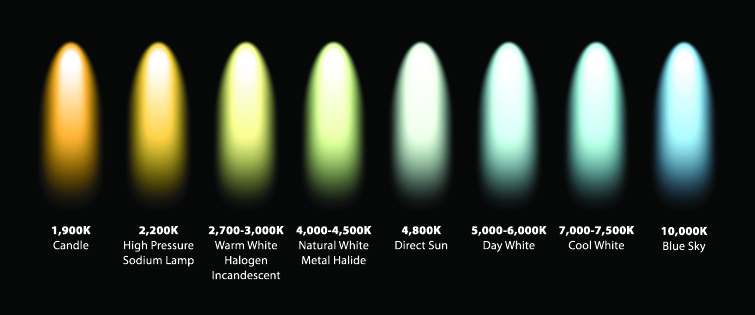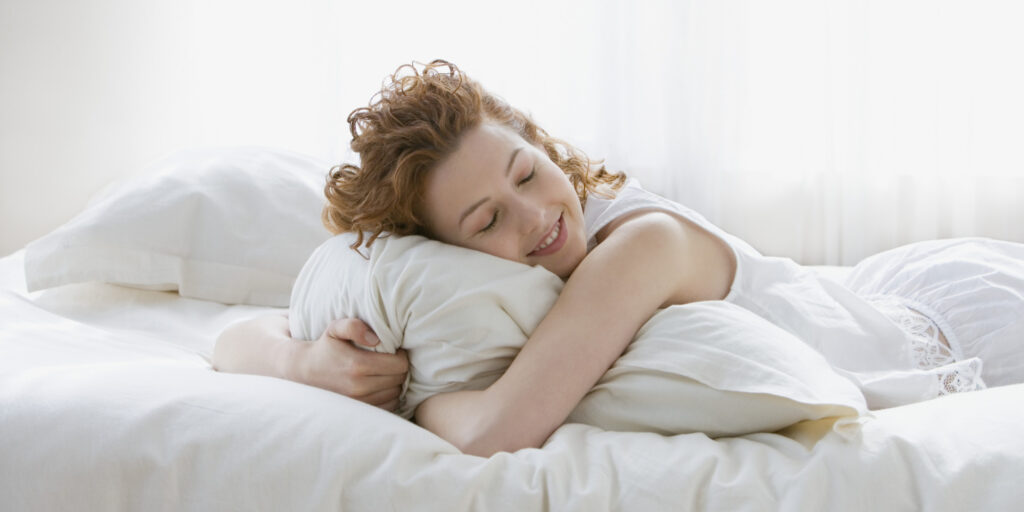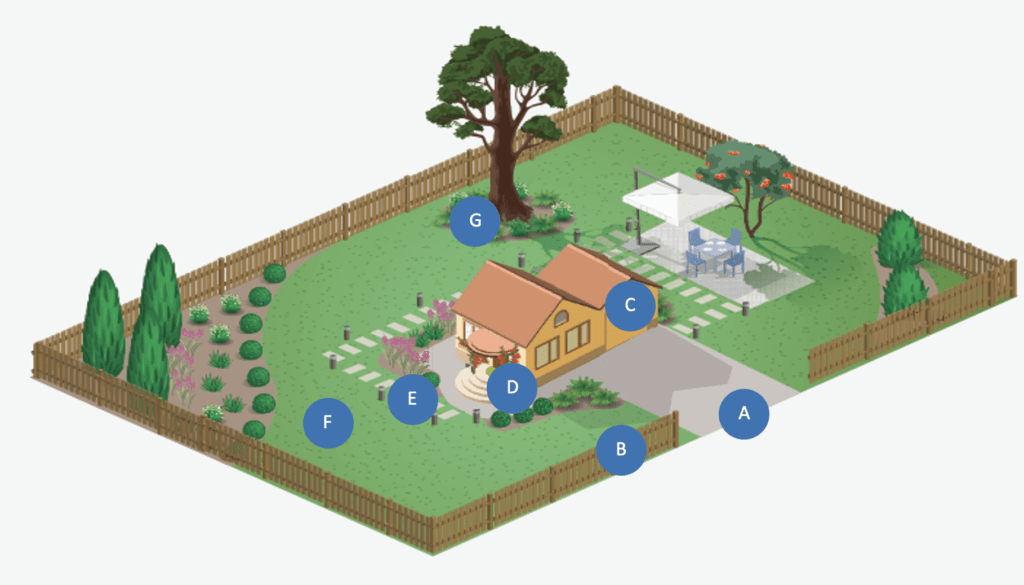What Is The Kelvin?
Most Comprehensive Explanation In Outdoor Lights Industry
Home – Info Center– Blogs – What Is The Kelvin?

By Michael Zhang || Updated on 25th Dec 2023
Michael Zhang is a seasoned professional with 15 years of experience in the solar lights industry. Throughout his career, he has been actively involved in product design and developing, gaining valuable expertise and insight into the industry. Known for his dedication and professionalism, Michael has contributed significantly to the growth and success of various solar lights projects. His extensive knowledge and hands-on experience make him a trusted authority in the field, and he continues to innovate and excel in his role.
Color temperature is an indicator that describes the color of light emitted by a light source and is an important concept in the field of lighting. It not only affects our perception and emotion of the environment, but also directly affects the choice and design of lighting products. With the development and wide application of LED technology, the concept of color temperature has become increasingly important. Therefore, an in-depth understanding of the meaning and impact of color temperature is crucial for us to correctly select outdoor lighting products and create a comfortable living and working environment.
Table of Contents
Basics Of Color Temperature
By adjusting the color temperature of the light source, we can create different environmental atmospheres, from a warm home atmosphere to a professional working environment, color temperature plays an important role. Therefore, the understanding and application of color temperature is even more one of the key factors in lighting design and life.

Kelvin is the unit of color temperature. Color temperature also referred to as colour appearance, colour temperature basically refers to how warm or cool a light appears. It focuses on what shade of white light is emitted from the bulb. A “warmer” visual effect is similar to an incandescent lamp while “cooler” visual effects are similar to fluorescent lights in industrial settings.
Colour temperature doesn’t refer to the colour of the bulb – like party lights or Christmas lights. It also doesn’t mean the heat physically given off by the bulb – like a bathroom heat lamp.
Color Temperature - What Does It Mean
The absolute temperature K (Kelvin, or Kelvin temperature) as a unit (K = ℃ + 273.15). Therefore, the black body is heated to a red temperature of about 527 ℃, or 800 K(=273+527), and other temperatures affect the change in light color. In the day, the light color of sunlight also changes with time: about 40 minutes after sunrise, the color of light is more yellow, color temperature 3,000K; midday sunlight is white, rising to 4,800-5,800K, cloudy noon is about 6,500K; sunset before the light color is reddish, the color temperature and down to paper 2,200K.
See here, do you still think it is too difficult to understand? Let’s take a simple example, if you place a dark-colored object at room temperature; it will initially appear black, which is obvious, if the object is now heated to 1,500 Kelvin, you will see its appearance turn red. Increase the temperature to 2700K and you will notice a warm yellow light emanating from the object. At temperatures above 4200K, the object will appear white, and above 5500K it will turn blue. As with a burning flame, the higher the temperature, the whiter and bluer the flame becomes.
Simply put, the concept of “color temperature” is a parameter used by humans to describe the color characteristics of light emitted by a light source. Similarly, now that you understand the concept, let us tell you a little trick to help you remember the color temperature, if the color temperature is lower than 2900K lights emit a warm yellow light, while the color temperature is higher than 3000K and 5000K lights emit a bright white light and cool white light respectively.
Why Is Color Temperature Important for Outdoor Lighting
Affects Comfort: The right color temperature creates a cosy atmosphere, making people feel more relaxed and happy. For example, choosing lower color temperatures at home, such as 3,000-4,000K, creates a warm and cosy atmosphere that helps to relax the mind and body.

Affects Work Efficiency: Different activities require different light color temperatures. In an office or study environment, choosing a higher color temperature light can increase alertness and concentration, and improve work and study efficiency. Color temperatures above 4000K mimic natural light and stop the production of melatonin, making the person under it more alert and awake.

Health Effects: A good lighting environment is important for protecting eye health and regulating biological rhythms. Choosing the right color temperature helps to reduce eye fatigue and keep the biological clock functioning properly. Lights with a color temperature below 3000K trigger the production of melatonin in the body. It is a hormone that initiates sleep and therefore makes people feel drowsy. These color temperatures are therefore suitable for relaxing and restful spaces.

According to the value of color temperature, we can classify the color temperature into low color temperature, medium color temperature and high color temperature:
Low Color Temperature: The color temperature is below 3300K, usually showing reddish light color, giving a warm and steady feeling, suitable for environments such as dining rooms and bedrooms.
Medium Color Temperature: Color temperature between 3000K and 6000K, soft and natural light, suitable for reading or places with specific brightness requirements, such as kitchens and bathrooms.
High color temperature: The color temperature is above 6000K, the light color is bluish and can focus the mind, suitable for offices and studios and other places that need a clear line of sight.
The most commonly used color temperatures for outdoor lighting products are 3000K, 4000K and 6000K.
The Difference Between Different Color Temperatures
| Light Color | Atmosphere | Application Areas | |
|---|---|---|---|
| 3000K | A warmer and softer light color, similar to the light at dusk | Creates a warm, relaxing atmosphere | Suitable for home environment, bedroom, living room, dining room and other places that need to create a warm atmosphere. |
| 4000K | Neutral tone of the light color, between warm white light and cold white light, closer to the natural light | Enhances the atmosphere of concentration and clarity | Suitable for offices, commercial premises, schools, hospitals and other places that need to improve work efficiency and visual comfort. |
| 6000K | A bright and clear light color, similar to the light in the daytime | Brings fresh and bright atmosphere | Suitable for factories, workshops, garages, outdoor public areas and other places that need higher brightness and clear vision. |
Color Temperature Preferences In Different Countries
In colder climates and environments, people may prefer warmer tones of light to create a warm and comfortable atmosphere; while in hotter climates and environments, people may prefer cooler tones of light to bring a sense of coolness.
The following are just some of the things we have learnt from communicating with our clients for your reference, the actual situation may vary depending on the region, cultural habits, personal preferences and other factors.
Cold Climate Countries
Canada: due to the cold climate, Canadians may prefer to choose warmer tones of light to create a warm and comfortable atmosphere.
Scandinavian countries (Norway, Sweden, Finland, etc.): Scandinavian countries have been in cold climates for a long time, and people usually prefer warmer shades of light to bring a sense of warmth.
Hot Climate Countries
Australia: Due to the hot climate in Australia, people may prefer cooler tones of light to bring a sense of coolness and freshness.
Middle Eastern countries (UAE, Saudi Arabia, etc.): With the hot and dry climate in the Middle East, people may prefer to choose cooler tones of light to provide a cool and comfortable interior.
Warm And Humid Climate Countries
Singapore: Singapore has a warm and humid climate and people may prefer cooler tones of light to reduce the stuffiness of the interior.
Mild Climate Countries
France : With a mild climate in France, people may not have a particular preference for color temperature, but may choose different color temperatures of light for different occasions and environments.
As some outdoor places need to improve safety and visibility, and some outdoor places need to be decorated as a more attractive space, then according to the different needs and purposes of the outdoor installation scene, choose the appropriate color temperature of the lamps can better meet the actual use and aesthetic needs of people, while enhancing the comfort and functionality of outdoor space.
Before we start to choose the color temperature, we need to take a look at some common installation scenes in outdoor gardens, and currently I have sorted out the following spaces:
How To Choose Color Temperature For Outdoor Lighting
As some outdoor living space need to improve safety and visibility, and some outdoor places need to be decorated as a more attractive space, then according to the different needs and purposes of the outdoor installation scene, choose the appropriate color temperature of the lamps can better meet the actual use and aesthetic needs of people, while enhancing the comfort and functionality of outdoor space.
Before we start to choose the color temperature, we need to take a look at some common installation scenes in outdoor gardens, and currently I have sorted out the following spaces:
Which In Is The Warm Light(3000K) Suitable For Installation
Warm white light creates an intimate atmosphere that promotes calm and relaxation. This is perfect for outdoor decorative ligg or areas such as outdoor living rooms and outdoor kitchens such as (B)fences,(E) pathways, pools,(E) ground&lawn.
Which In Is The White Light(4000K) Suitable For Installation
Cool white light is bright and vibrant, perfect for chasing away shadows and giving a clear view of your surroundings. For example,(C) Walls, (E) pathways,(G) trees, posts, and other areas of the garden.
Which In Is The Cool White Light(6000K) Suitable For Installation
The use of white light is ideal for areas that need to be focused on for security purposes, e.g. (C)Garages, Chicken Sheds, Storage Sheds, corners.
How To Measure Color Temperature
Measuring color temperature can help to ensure the quality of lighting, regulate the ambience, promote health and improve the quality of life, and is therefore of great value in various fields of application. At the same time, color temperature is one of the most important indicators of lighting quality. By accurately measuring the color temperature, it can be ensured that the light provided by the lighting equipment meets the expected color requirements, thus guaranteeing the quality and consistency of the lighting effect. We will introduce the following three color temperature testing methods:
Color Temperature Meter
A color temperature meter is a professional optical instrument that can directly measure the color temperature of a light source. Users will be placed in the light source to be tested within the irradiation range, the instrument will be through the optical sensor to measure the color temperature of the light source, and display the results in Kelvin (K) units.
Spectrometer
A spectrometer is a high-precision optical device that analyses the spectrum emitted by a light source and calculates the corresponding color temperature from the spectral data. When the user points the spectrometer at the light source, the instrument will analyse the spectral curve emitted by the light source and calculate the color temperature value accordingly. In our factory, we usually use an integrating sphere for testing, because there is also a spectrometer inside the integrating sphere. Therefore, when testing outdoor solar lights, the integrating sphere can completely replace a separate spectrometer.
Mobile Apps
Some smartphones are equipped with professional color temperature measurement apps, through which users can measure the color temperature of a light source. These apps usually use the phone’s camera to capture an image of the light source and analyse the color information in the image through an algorithm to calculate the color temperature value.
Among these four testing methods, spectrometer is the most accurate. Spectrometer is able to analyse the spectral curve emitted by the light source and calculate the corresponding color temperature value based on the complete spectral data. Compared with other methods, spectrometer can provide more accurate and comprehensive spectral information, thus obtaining more precise color temperature measurement results.
Error Criteria For Color Temperature Data
The international organisations do not have a uniform value for the error of color temperature data, but determine it according to the specific application and requirements. For outdoor lighting products, the Chinese standard requires that the color temperature error range is usually within ±10%.
FAQs
No, to be precise, 5000K is just whiter than 3000K, not brighter. To compare which of the two lamps is the brightest, the parameter to compare is lumens, not color temperature.
3000-4000K, Suitable for most installation scenarios, it creates a nice cosy and quiet atmosphere.
No, 3000K is a very neutral color temperature and doesn't feel cold.
The color temperature of natural sunlight varies throughout the day, but averages around 5000K to 6500 K. Therefore, LED lights with a color temperature in this range (often labelled 'Daylight' or 'Cool White') most closely simulate natural sunlight. These lights emit a bright white light with a slightly bluish hue, similar to midday sunlight.
It's hard to answer, but the approximate range is 3000-6000K, which is the most common color temperature for both indoors and outdoors.
Typically, flood lights are lights intended for installation, then we recommend the 6000K.
Conclusion
Colour temperature is a key factor that must be considered when selecting LEDs for residential and commercial buildings. It affects the mood, ambience and performance of individuals working under these lights. You should choose the colour temperature based on the function of the space and the ambience you want to maintain. That’s what this article is about.
Are you still struggling to find solar lights suppliers with consistent good quality and great service? Work with Fligreen for all your solar garden lights needs. Contact us to work with the most professional and reliable manufacturer, Let us light your way to a sustainable future.
Related Blogs
Share Via:
Get in Touch with Us Now!
Got questions or feedback? We’d love to hear from you! Just fill out the form below, and our friendly team will respond ASAP.

